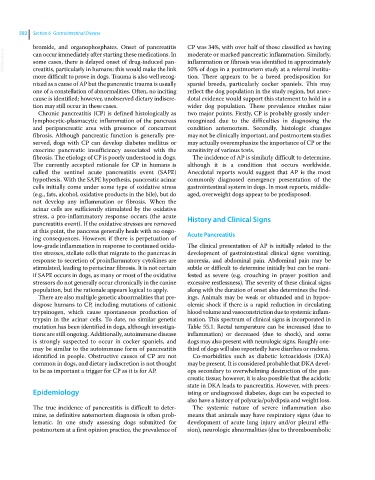Page 624 - Clinical Small Animal Internal Medicine
P. 624
592 Section 6 Gastrointestinal Disease
bromide, and organophosphates. Onset of pancreatitis CP was 34%, with over half of those classified as having
VetBooks.ir can occur immediately after starting these medications. In moderate or marked pancreatic inflammation. Similarly,
inflammation or fibrosis was identified in approximately
some cases, there is delayed onset of drug‐induced pan-
creatitis, particularly in humans; this would make the link
tion. There appears to be a breed predisposition for
more difficult to prove in dogs. Trauma is also well recog- 50% of dogs in a postmortem study at a referral institu-
nized as a cause of AP but the pancreatic trauma is usually spaniel breeds, particularly cocker spaniels. This may
one of a constellation of abnormalities. Often, no inciting reflect the dog population in the study region, but anec-
cause is identified; however, unobserved dietary indiscre- dotal evidence would support this statement to hold in a
tion may still occur in these cases. wider dog population. These prevalence studies raise
Chronic pancreatitis (CP) is defined histologically as two major points. Firstly, CP is probably grossly under-
lymphocytic‐plasmacytic inflammation of the pancreas recognized due to the difficulties in diagnosing the
and peripancreatic area with presence of concurrent condition antemortem. Secondly, histologic changes
fibrosis. Although pancreatic function is generally pre- may not be clinically important, and postmortem studies
served, dogs with CP can develop diabetes mellitus or may actually overemphasize the importance of CP or the
exocrine pancreatic insufficiency associated with the sensitivity of various tests.
fibrosis. The etiology of CP is poorly understood in dogs. The incidence of AP is similarly difficult to determine,
The currently accepted rationale for CP in humans is although it is a condition that occurs worldwide.
called the sentinel acute pancreatitis event (SAPE) Anecdotal reports would suggest that AP is the most
hypothesis. With the SAPE hypothesis, pancreatic acinar commonly diagnosed emergency presentation of the
cells initially come under some type of oxidative stress gastrointestinal system in dogs. In most reports, middle‐
(e.g., fats, alcohol, oxidative products in the bile), but do aged, overweight dogs appear to be predisposed.
not develop any inflammation or fibrosis. When the
acinar cells are sufficiently stimulated by the oxidative
stress, a pro-inflammatory response occurs (the acute History and Clinical Signs
pancreatitis event). If the oxidative stresses are removed
at this point, the pancreas generally heals with no ongo- Acute Pancreatitis
ing consequences. However, if there is perpetuation of
low‐grade inflammation in response to continued oxida- The clinical presentation of AP is initially related to the
tive stresses, stellate cells that migrate to the pancreas in development of gastrointestinal clinical signs: vomiting,
response to secretion of proinflammatory cytokines are anorexia, and abdominal pain. Abdominal pain may be
stimulated, leading to periacinar fibrosis. It is not certain subtle or difficult to determine initially but can be mani-
if SAPE occurs in dogs, as many or most of the oxidative fested as severe (e.g. crouching in prayer position and
stressors do not generally occur chronically in the canine excessive restlessness). The severity of these clinical signs
population, but the rationale appears logical to apply. along with the duration of onset also determines the find-
There are also multiple genetic abnormalities that pre- ings. Animals may be weak or obtunded and in hypov-
dispose humans to CP, including mutations of cationic olemic shock if there is a rapid reduction in circulating
trypsinogen, which cause spontaneous production of blood volume and vasoconstriction due to systemic inflam-
trypsin in the acinar cells. To date, no similar genetic mation. This spectrum of clinical signs is incorporated in
mutation has been identified in dogs, although investiga- Table 55.1. Rectal temperature can be increased (due to
tions are still ongoing. Additionally, autoimmune disease inflammation) or decreased (due to shock), and some
is strongly suspected to occur in cocker spaniels, and dogs may also present with neurologic signs. Roughly one‐
may be similar to the autoimmune form of pancreatitis third of dogs will also reportedly have diarrhea or melena.
identified in people. Obstructive causes of CP are not Co‐morbidities such as diabetic ketoacidosis (DKA)
common in dogs, and dietary indiscretion is not thought may be present. It is considered probable that DKA devel-
to be as important a trigger for CP as it is for AP. ops secondary to overwhelming destruction of the pan-
creatic tissue; however, it is also possible that the acidotic
state in DKA leads to pancreatitis. However, with preex-
Epidemiology isting or undiagnosed diabetes, dogs can be expected to
also have a history of polyuria/polydipsia and weight loss.
The true incidence of pancreatitis is difficult to deter- The systemic nature of severe inflammation also
mine, as definitive antemortem diagnosis is often prob- means that animals may have respiratory signs (due to
lematic. In one study assessing dogs submitted for develop ment of acute lung injury and/or pleural effu-
postmortem at a first opinion practice, the prevalence of sion), neurologic abnormalities (due to thromboembolic

